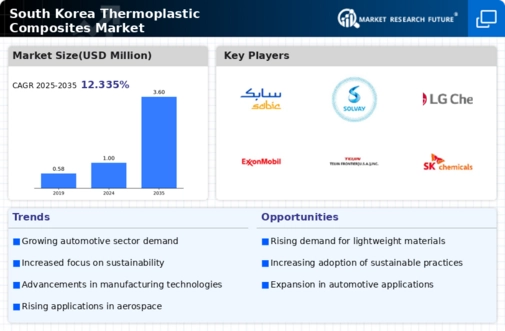The South Korea Thermoplastic Composites Market has been experiencing significant growth, driven by the increasing demand for lightweight, high-performance materials across various industries, including automotive, aerospace, and electronics. Competitive insights into this market indicate that numerous companies are vying for a prominent position by harnessing advanced technologies and innovative solutions. The demand for thermoplastic composites is propelled by their excellent mechanical properties, ease of fabrication, and recyclability, making them an attractive option for manufacturers focused on sustainability and enhanced product performance.
As businesses continue to seek solutions that meet stringent regulatory standards and performance criteria, competition intensifies, necessitating a deeper understanding of market players, their strategies, and technological advancements that shape this sector.SABIC, a leading global supplier of thermoplastic composites, boasts a significant presence in the South Korean market by leveraging its extensive portfolio of innovative materials.
Their products cater to various industries, enhancing the performance and efficiency of applications ranging from automotive components to electronic devices. SABIC's strengths lie in its strong research and development capabilities, allowing the company to continuously innovate and tailor its offerings to meet the specific needs of the South Korean market. Additionally, the company's established supply chain and strong relationships with local customers bolster its competitive standing, enabling it to quickly respond to market trends and customer demands.
SABIC's commitment to sustainability further enhances its reputation, as the company continually explores eco-friendly alternatives within its product range, aligning its growth strategy with the global shift towards reduced environmental impact.Solvay is another key player in the South Korea Thermoplastic Composites Market, known for its wide-ranging solutions that include high-performance materials designed for demanding applications. The company has made significant inroads in various sectors, particularly automotive and aerospace, where the lightweight and durable characteristics of its thermoplastic composites are increasingly favored.
Solvay’s strengths lie in its robust technical expertise and deep understanding of market needs, which enables the company to offer customized solutions that meet specific performance criteria. Furthermore, Solvay actively engages in strategic mergers and acquisitions to enhance its capabilities and expand its market reach within South Korea. By continually investing in research and development, Solvay remains at the forefront of innovation, producing key products such as composite materials that are not just functional but also contribute to greater energy efficiency and reduced carbon footprints in manufacturing processes.























Leave a Comment